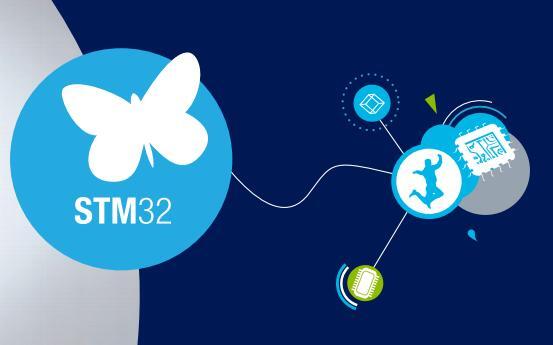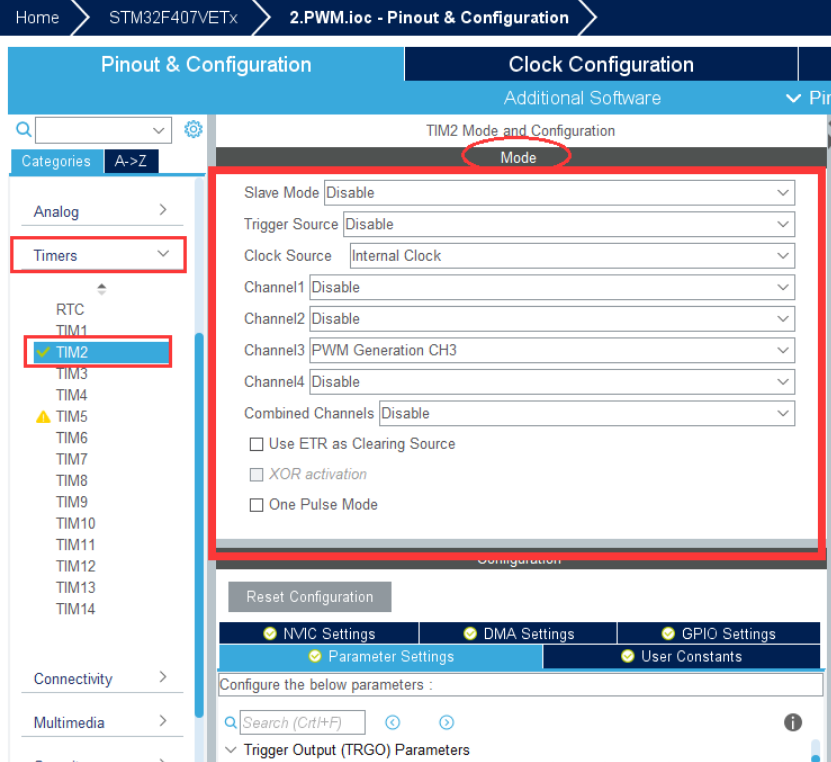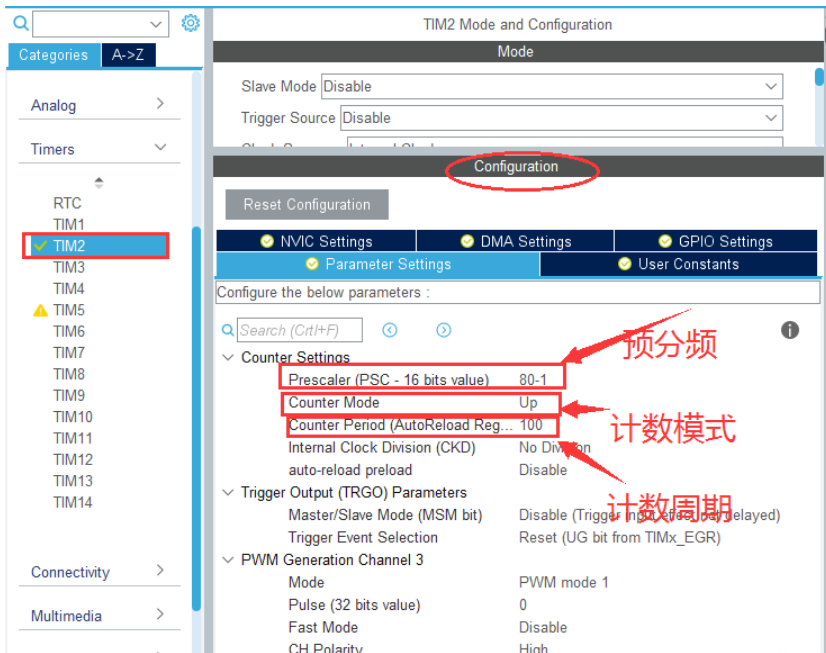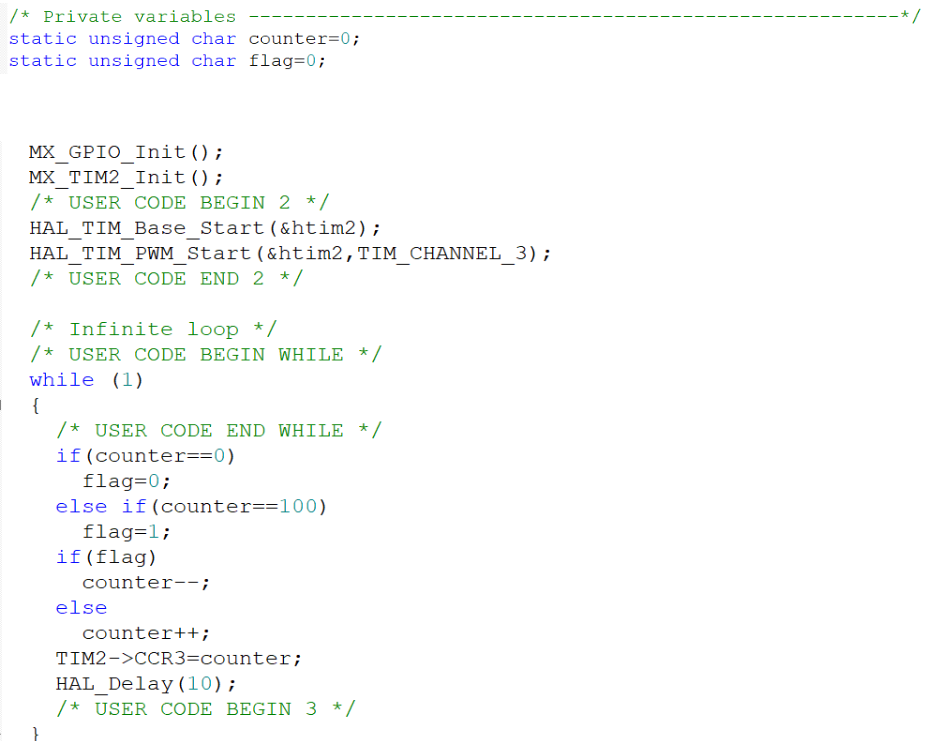【STM32】CubeMX+HAL 输出 PWM

Author:AXYZdong
自动化专业 工科男
有一点思考,有一点想法,有一点理性!
定个小小目标,努力成为习惯!在最美的年华遇见更好的自己!
更多精彩文章前往:👉 个人主页
1. 配置 STM32CubeMX
前面的一些基础步骤可参见:【STM32】CubeMX+HAL 点亮 LED 的【1.1】~【1.6】步骤。
核心配置:
这里我使用的是 TIM2 定时器,当然使用其他的也可以,但要注意相关配置。
1.1 TIM2 的 Mode 配置

1.2 TIM2 的 Configuration 配置

1.3 其余 GPIO 配置
PA2 的 PWM 输出作为 PA6 的输入,PA6 连接的是一个 LED ,观察是否出现呼吸灯现象。

余下步骤可参见:【STM32】CubeMX+HAL 点亮 LED 的【1.10】~【1.13】步骤。
2. 添加代码

下面贴出主要代码:
2.1 gpio.c
/** ****************************************************************************** * File Name : gpio.c * Description : This file provides code for the configuration * of all used GPIO pins. ****************************************************************************** * @attention * * <h2><center>© Copyright (c) 2020 STMicroelectronics. * All rights reserved.</center></h2> * * This software component is licensed by ST under BSD 3-Clause license, * the "License"; You may not use this file except in compliance with the * License. You may obtain a copy of the License at: * opensource.org/licenses/BSD-3-Clause * ****************************************************************************** */
/* Includes ------------------------------------------------------------------*/#include "gpio.h"/* USER CODE BEGIN 0 */
/* USER CODE END 0 */
/*----------------------------------------------------------------------------*//* Configure GPIO *//*----------------------------------------------------------------------------*//* USER CODE BEGIN 1 */
/* USER CODE END 1 */
/** Configure pins as * Analog * Input * Output * EVENT_OUT * EXTI*/void MX_GPIO_Init(void){
GPIO_InitTypeDef GPIO_InitStruct = {0};
/* GPIO Ports Clock Enable */ __HAL_RCC_GPIOC_CLK_ENABLE(); __HAL_RCC_GPIOH_CLK_ENABLE(); __HAL_RCC_GPIOA_CLK_ENABLE();
/*Configure GPIO pin : PA6 */ GPIO_InitStruct.Pin = GPIO_PIN_6; GPIO_InitStruct.Mode = GPIO_MODE_INPUT; GPIO_InitStruct.Pull = GPIO_NOPULL; HAL_GPIO_Init(GPIOA, &GPIO_InitStruct);
}
/* USER CODE BEGIN 2 */
/* USER CODE END 2 */
/************************ (C) COPYRIGHT STMicroelectronics *****END OF FILE****/
2.2 time.c
/** ****************************************************************************** * File Name : TIM.c * Description : This file provides code for the configuration * of the TIM instances. ****************************************************************************** * @attention * * <h2><center>© Copyright (c) 2020 STMicroelectronics. * All rights reserved.</center></h2> * * This software component is licensed by ST under BSD 3-Clause license, * the "License"; You may not use this file except in compliance with the * License. You may obtain a copy of the License at: * opensource.org/licenses/BSD-3-Clause * ****************************************************************************** */
/* Includes ------------------------------------------------------------------*/#include "tim.h"
/* USER CODE BEGIN 0 */
/* USER CODE END 0 */
TIM_HandleTypeDef htim2;
/* TIM2 init function */void MX_TIM2_Init(void){ TIM_ClockConfigTypeDef sClockSourceConfig = {0}; TIM_MasterConfigTypeDef sMasterConfig = {0}; TIM_OC_InitTypeDef sConfigOC = {0};
htim2.Instance = TIM2; htim2.Init.Prescaler = 80-1; htim2.Init.CounterMode = TIM_COUNTERMODE_UP; htim2.Init.Period = 100; htim2.Init.ClockDivision = TIM_CLOCKDIVISION_DIV1; htim2.Init.AutoReloadPreload = TIM_AUTORELOAD_PRELOAD_DISABLE; if (HAL_TIM_Base_Init(&htim2) != HAL_OK) { Error_Handler(); } sClockSourceConfig.ClockSource = TIM_CLOCKSOURCE_INTERNAL; if (HAL_TIM_ConfigClockSource(&htim2, &sClockSourceConfig) != HAL_OK) { Error_Handler(); } if (HAL_TIM_PWM_Init(&htim2) != HAL_OK) { Error_Handler(); } sMasterConfig.MasterOutputTrigger = TIM_TRGO_RESET; sMasterConfig.MasterSlaveMode = TIM_MASTERSLAVEMODE_DISABLE; if (HAL_TIMEx_MasterConfigSynchronization(&htim2, &sMasterConfig) != HAL_OK) { Error_Handler(); } sConfigOC.OCMode = TIM_OCMODE_PWM1; sConfigOC.Pulse = 0; sConfigOC.OCPolarity = TIM_OCPOLARITY_HIGH; sConfigOC.OCFastMode = TIM_OCFAST_DISABLE; if (HAL_TIM_PWM_ConfigChannel(&htim2, &sConfigOC, TIM_CHANNEL_3) != HAL_OK) { Error_Handler(); } HAL_TIM_MspPostInit(&htim2);
}
void HAL_TIM_Base_MspInit(TIM_HandleTypeDef* tim_baseHandle){
if(tim_baseHandle->Instance==TIM2) { /* USER CODE BEGIN TIM2_MspInit 0 */
/* USER CODE END TIM2_MspInit 0 */ /* TIM2 clock enable */ __HAL_RCC_TIM2_CLK_ENABLE(); /* USER CODE BEGIN TIM2_MspInit 1 */
/* USER CODE END TIM2_MspInit 1 */ }}void HAL_TIM_MspPostInit(TIM_HandleTypeDef* timHandle){
GPIO_InitTypeDef GPIO_InitStruct = {0}; if(timHandle->Instance==TIM2) { /* USER CODE BEGIN TIM2_MspPostInit 0 */
/* USER CODE END TIM2_MspPostInit 0 */ __HAL_RCC_GPIOA_CLK_ENABLE(); /**TIM2 GPIO Configuration PA2 ------> TIM2_CH3 */ GPIO_InitStruct.Pin = GPIO_PIN_2; GPIO_InitStruct.Mode = GPIO_MODE_AF_PP; GPIO_InitStruct.Pull = GPIO_NOPULL; GPIO_InitStruct.Speed = GPIO_SPEED_FREQ_LOW; GPIO_InitStruct.Alternate = GPIO_AF1_TIM2; HAL_GPIO_Init(GPIOA, &GPIO_InitStruct);
/* USER CODE BEGIN TIM2_MspPostInit 1 */
/* USER CODE END TIM2_MspPostInit 1 */ }
}
void HAL_TIM_Base_MspDeInit(TIM_HandleTypeDef* tim_baseHandle){
if(tim_baseHandle->Instance==TIM2) { /* USER CODE BEGIN TIM2_MspDeInit 0 */
/* USER CODE END TIM2_MspDeInit 0 */ /* Peripheral clock disable */ __HAL_RCC_TIM2_CLK_DISABLE(); /* USER CODE BEGIN TIM2_MspDeInit 1 */
/* USER CODE END TIM2_MspDeInit 1 */ }}
/* USER CODE BEGIN 1 */
/* USER CODE END 1 */
/************************ (C) COPYRIGHT STMicroelectronics *****END OF FILE****/
2.3 main.c
/* USER CODE BEGIN Header *//** ****************************************************************************** * @file : main.c * @brief : Main program body ****************************************************************************** * @attention * * <h2><center>© Copyright (c) 2020 STMicroelectronics. * All rights reserved.</center></h2> * * This software component is licensed by ST under BSD 3-Clause license, * the "License"; You may not use this file except in compliance with the * License. You may obtain a copy of the License at: * opensource.org/licenses/BSD-3-Clause * ****************************************************************************** *//* USER CODE END Header */
/* Includes ------------------------------------------------------------------*/#include "main.h"#include "tim.h"#include "gpio.h"
/* Private includes ----------------------------------------------------------*//* USER CODE BEGIN Includes */
/* USER CODE END Includes */
/* Private typedef -----------------------------------------------------------*//* USER CODE BEGIN PTD */
/* USER CODE END PTD */
/* Private define ------------------------------------------------------------*//* USER CODE BEGIN PD */
/* USER CODE END PD */
/* Private macro -------------------------------------------------------------*//* USER CODE BEGIN PM */
/* USER CODE END PM */
/* Private variables ---------------------------------------------------------*/static unsigned char counter=0;static unsigned char flag=0;/* USER CODE BEGIN PV */
/* USER CODE END PV */
/* Private function prototypes -----------------------------------------------*/void SystemClock_Config(void);/* USER CODE BEGIN PFP */
/* USER CODE END PFP */
/* Private user code ---------------------------------------------------------*//* USER CODE BEGIN 0 */
/* USER CODE END 0 */
/** * @brief The application entry point. * @retval int */int main(void){ /* USER CODE BEGIN 1 */
/* USER CODE END 1 */
/* MCU Configuration--------------------------------------------------------*/
/* Reset of all peripherals, Initializes the Flash interface and the Systick. */ HAL_Init();
/* USER CODE BEGIN Init */
/* USER CODE END Init */
/* Configure the system clock */ SystemClock_Config();
/* USER CODE BEGIN SysInit */
/* USER CODE END SysInit */
/* Initialize all configured peripherals */ MX_GPIO_Init(); MX_TIM2_Init(); /* USER CODE BEGIN 2 */ HAL_TIM_Base_Start(&htim2); HAL_TIM_PWM_Start(&htim2,TIM_CHANNEL_3); /* USER CODE END 2 */
/* Infinite loop */ /* USER CODE BEGIN WHILE */ while (1) { /* USER CODE END WHILE */ if(counter==0) flag=0; else if(counter==100) flag=1; if(flag) counter--; else counter++; TIM2->CCR3=counter; HAL_Delay(10); /* USER CODE BEGIN 3 */ } /* USER CODE END 3 */}
/** * @brief System Clock Configuration * @retval None */void SystemClock_Config(void){ RCC_OscInitTypeDef RCC_OscInitStruct = {0}; RCC_ClkInitTypeDef RCC_ClkInitStruct = {0};
/** Configure the main internal regulator output voltage */ __HAL_RCC_PWR_CLK_ENABLE(); __HAL_PWR_VOLTAGESCALING_CONFIG(PWR_REGULATOR_VOLTAGE_SCALE1); /** Initializes the CPU, AHB and APB busses clocks */ RCC_OscInitStruct.OscillatorType = RCC_OSCILLATORTYPE_HSI; RCC_OscInitStruct.HSIState = RCC_HSI_ON; RCC_OscInitStruct.HSICalibrationValue = RCC_HSICALIBRATION_DEFAULT; RCC_OscInitStruct.PLL.PLLState = RCC_PLL_NONE; if (HAL_RCC_OscConfig(&RCC_OscInitStruct) != HAL_OK) { Error_Handler(); } /** Initializes the CPU, AHB and APB busses clocks */ RCC_ClkInitStruct.ClockType = RCC_CLOCKTYPE_HCLK|RCC_CLOCKTYPE_SYSCLK |RCC_CLOCKTYPE_PCLK1|RCC_CLOCKTYPE_PCLK2; RCC_ClkInitStruct.SYSCLKSource = RCC_SYSCLKSOURCE_HSI; RCC_ClkInitStruct.AHBCLKDivider = RCC_SYSCLK_DIV1; RCC_ClkInitStruct.APB1CLKDivider = RCC_HCLK_DIV1; RCC_ClkInitStruct.APB2CLKDivider = RCC_HCLK_DIV1;
if (HAL_RCC_ClockConfig(&RCC_ClkInitStruct, FLASH_LATENCY_0) != HAL_OK) { Error_Handler(); }}
/* USER CODE BEGIN 4 */
/* USER CODE END 4 */
/** * @brief This function is executed in case of error occurrence. * @retval None */void Error_Handler(void){ /* USER CODE BEGIN Error_Handler_Debug */ /* User can add his own implementation to report the HAL error return state */
/* USER CODE END Error_Handler_Debug */}
#ifdef USE_FULL_ASSERT/** * @brief Reports the name of the source file and the source line number * where the assert_param error has occurred. * @param file: pointer to the source file name * @param line: assert_param error line source number * @retval None */void assert_failed(uint8_t *file, uint32_t line){ /* USER CODE BEGIN 6 */ /* User can add his own implementation to report the file name and line number, tex: printf("Wrong parameters value: file %s on line %d\r\n", file, line) */ /* USER CODE END 6 */}#endif /* USE_FULL_ASSERT */
/************************ (C) COPYRIGHT STMicroelectronics *****END OF FILE****/
3. 总结
TIM的配置是本工程的核心通过观察
LED判断是否输出成功,当然有条件的可以使用示波器看看波形STM32的基础配置用CubeMX很是方便
猜你喜欢:
【STM32】0.96 寸 OLED 显示屏(7 针 SPI 协议)软件模拟 SPI
【STM32】1.44 寸 TFT 液晶屏显示字符、汉字和图片
【STM32】stm32f407 + DS18B20 碰出不一样的火花
【STM32】ST-LINK 下载器下载后需复位,程序才运行的问题
本次的分享就到这里
如果我的文章对你有帮助、如果你喜欢我的文章内容,请 “点赞” “评论” “收藏” 一键三连哦!
听说 👉 点赞 👈 的人运气不会太差,每一天都会元气满满呦!^ _ ^
码字不易,大家的支持就是我坚持下去的动力。点赞后不要忘了👉 关注 👈我哦!
如果以上内容有任何错误或者不准确的地方,欢迎在下面👇留个言。或者你有更好的想法,欢迎一起交流学习~~~
版权声明: 本文为 InfoQ 作者【AXYZdong】的原创文章。
原文链接:【http://xie.infoq.cn/article/87f2c3a5ad84905df1d0de7fb】。文章转载请联系作者。
AXYZdong
没有伞的孩子要学会奔跑! 2020.06.01 加入
自动化专业 工科男 有一点思考,有一点想法,有一点理性。 定个小小目标,努力成为习惯。












评论